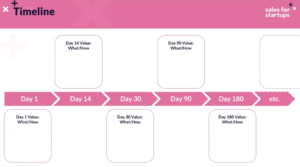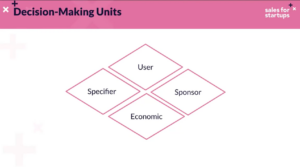We recently held a session with our Founder & CEO, James Ker-Reid, who talked us through what the necessary elements are for any B2B tech startup that is trying to build its revenue engine.
If you missed Part 1 that looked at introducing the topic and identifying new market segments, you can find that here. If you’d rather watch the session, click here to view the recording via our YouTube channel.
3. How do I grow my existing accounts?
One of the biggest failure points in Seed and Series A startups is that they are absolutely hell-bent on acquisition, and I can understand why! But retention and net revenue retention is really a precursor for success and long-term profitability.
What we see in B2B SaaS companies over a six or seven-year period leading up to acquisition and IPO, often the existing customer spend and lifetime value contribution to the overall revenue of the company starts to overtake the new business acquisition.
They’re paying the majority of the company’s expansion and become very important to growth, especially as it becomes harder to sign new clients as your market share increases.
A couple of things to consider when growing existing accounts:
- Structure
- Roles & Responsibilities
- Retention
- Renewals
- Upselling & cross-selling
- Incentives
- Segment their customer base
- Operating model
The first thing you’ll want to consider is your Structure, and how that breaks down into your Roles & Responsibilities. Who’s going to own that between Sales, Customer Success and even what role Marketing has to play in this as well as Product. What are the interactions between those different members? Who is owning that in terms of management and oversight?
In the early stages that will often be the CEO, but later down the road will that be the VP of Sales? Will that be your VP of Customer Success? These are all considerations that take some deep thought and analysis to make, rather than what we often see which is an emotional (and sometimes illogical!) decision by CEOs.
In terms of Incentives, these do drive behaviours. This goes from how you draw up your commission plans and your bonus schemes to progression paths and performance reviews.
Segmenting your customer base will depend on where you are at. You may have quite a broad range of customers at the early stages (such as those that have come through referrals, some through VCs/investors/angels vs. those that you’ve grown organically). So it might be a range in terms of the buyer personas but also a range in terms of the size of those customers and the use cases they’ll have as well.
Try and segment at a top-level (such as employee size, for example) or customer lifetime value but I would encourage you to look at use cases at this point as well. If we’re trying to get a wider market adoption then we need to understand what those customers are using our platform for. That will enable our Operating model and how we organise the team – which in turn feeds back into our structure of the team.
Key problems with growing existing accounts
Some common problems we often hear about are as follows:
- Churn
- Poor customer satisfaction
- Resources: do we have enough?
- Product limitations: is it fit for purpose?
- Growth and expansion: who’s taking care of this?
I hear phrases like ‘My customer success team can’t sell’ or ‘We’re losing two customers for every three we’re acquiring’ or ‘We just don’t have the bandwidth right now some I’m doing it’. Some of these things need to be really evaluated properly, rather than given an emotional blanket judgment as to how the company, as well as the product, interacts with the market.
Timeline to value
A lot of people talk about customer journey mapping. I agree that’s a valuable exercise – but go one step further with it. Think about how your customers receive value, and what they’d receive when they do – even down to the product and feature level:

We’re really talking about user stories in terms of the level of detail with regards to that customer success journey that you’re drawing out and articulating here.
You can even then give confidence to those new buyers, especially if you’re selling at the Mid-Market or Enterprise level. There’s going to be an emphasis on the onboarding and ramping up of your customers – how do you make your customers successful? If you’re able to tell the story of how customers are successful, and what features/parts of the product they’re using consistently in order to reap value, then it’s really going to reflect product development and operational spend.
Decision-Making Units

For those wanting to expand accounts, this diagram comes from Miller Heiman which I find quite useful:
- User: The person who’ll actually be leveraging your product
- Sponsor: That coach that has brought you in – they’re obviously a fan.
- Economic: The budget holder
- Specifier: The person who articulates the outcomes that you’re trying to achieve with that product, i.e. what it’s there to solve. Very important that we match those goals (as we discussed with Accomplish previously).
Some Must-Haves (when setting up your account plan)
- Goals and objectives
- People: That’s not just internally but externally to – who are the people at the company you’re looking to grow within who are going to make this a success?
- Projects & Activities: They’re going to need to be done in that 30, 60, 90-day horizon that we looked at in order to make this a successful journey.
- Resources, risks, and contingencies: Think about a Plan B – if your user doesn’t log on in the first 30 days, what are you going to do?
- KPIs & Metrics: Don’t just think about lagging metrics like net churn or net revenue retention, you need to be thinking about logins, use of features, customer requests, etc.
4. How do you build an indirect and partner channel?
There are some key considerations here. It may be that it’s a little too early for your business but we wanted to capture a brief overview:
- What do you have that they don’t have?
- What do they have that you don’t have?
- Who are your ideal customers? Are any of them theirs?
- What would the first 30, 60, 90 days look like?
- What value can you give them?
It’s really important that you think about the value to the partner first, in terms of what you can give them. In startups what we have is creativity, we often have a lot of perseverance and persistence which we need to cash in to mobilise a partnership. You certainly want it to be a ‘give, give, give’ relationship to kick it off.
5. How do you integrate sales technology into your revenue operations?
Before you implement a new tool or technology, you should ask yourself these five things:
- How is this job done now?
- What can be eliminated, started, or improved?
- Will the customer benefit?
- Will we benefit?
- Who, how and over what timeframe will we measure its effect?
A few key areas that we see sales technology work well within:
Proposal Software: Certainly enables the Sales and Marketing team to collaborate, and to think about how you can articulate your value clearly. It’s also a lot easier for people to access proposals, rather than trying to find the 7th version on a Sharepoint drive!
Revenue Ops: Looking at deal intelligence, looking at where deals are not following consistent trends based on previous buying habits, therefore they may be at risk and you can set up manager alerts.
Document storage: Clearly if you’ve got a lot of sales collateral and marketing collateral, having a central place where that is deposited and used/modified/edited makes life a lot easier.
If you’re interested in checking out the Q&A section at the end of this masterclass, head on over to the recording here (from 22:07).